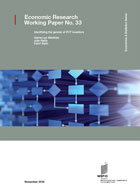Innovation Gender Gap: What Do We Know About the Gender Gap in Innovation?
Women innovating, inventing, and creating face constant factors that impede their activities. What can economic research tell us about these and inform gender balance policies?

The Gender Gap in innovation increases along women's career path
In an average high-income country, both women and men may have equal access to early education opportunities that would propel their careers forward. For instance, more women are graduating from bachelor and master programs than men.
However, the gender distribution flips over after this stage and worsens over time
- Fewer women graduate from Ph.D. programs than men;
- Fewer women get positions as researchers or professors than men;
- Women researchers earn, publish or patent less than men; and
- The Gender Gap in patenting is worse than in scientific papers.
Women and men are equally productive in innovation and creative activities
Once we factor in all elements, there is no evidence of a productivity gap between innovative and creative women and men. Most of the perceived differences can be explained by
- A lower position in the academic or corporate hierarchy than deserved; and
- Lack of encouragement for women; an
- Even when women are found to patent less than men, the quality and impact of their patents are often higher than those of their male counterparts.
Work Environments can discourage women's innovation
Working environments and organizational structure also explain the Gender Gap in innovation
- Women working in firms with too hierarchical organizational structures are less likely to participate in patenting;
- Women in more flexible firms – such as biotech or life sciences industries – are more likely to patent than the industries as a whole;
- Women are more likely to patent when part of larger research groups;
- Women are less likely to be single authors of scientific papers or patents; and
- Women are more likely to be excluded in patents than scientific publications, even when entitled to both.
The gender gap is not equal across industries
Industries show noticeable differences in terms of the Gender Gap:
- Life sciences and biotech industries offer more opportunities to women;
- Life sciences industries outperform IT-related industries, but they do much better than more traditional engineering industries;
- Women's representation is higher in academia than in industry; and
- We also observe these differences in the enrollment and graduation to fields leading to these industries.
Amid the bad news, there is room for hope
Even if most countries and industries show a gender gap, the vast majority of them show signs of an upward trend in women's contributions to innovation, particularly in patenting.
Reading list
Want to become a specialist on the subject? Dive into the list below containing relevant innovation and IP gender literature for your research:
Other stories you may enjoy

How to measure the Gender Gap in Innovation
There are several ways to get innovation and IP data with gender breakdown. Check which one suits your case better.

Creating a World Gender Name Dictionary
The World Gender Name Dictionary (WGND) is a tool to assist researchers and policy analysts worldwide in solving the lack of data sources with gender breakdown.
Related resources

Identifying the gender of PCT inventors
This paper analyzes the gender of inventors in international patent applications. We compile a worldwide gender-name dictionary, which includes 6.2 million names for 182 different countries to disambiguate the gender of PCT inventors.